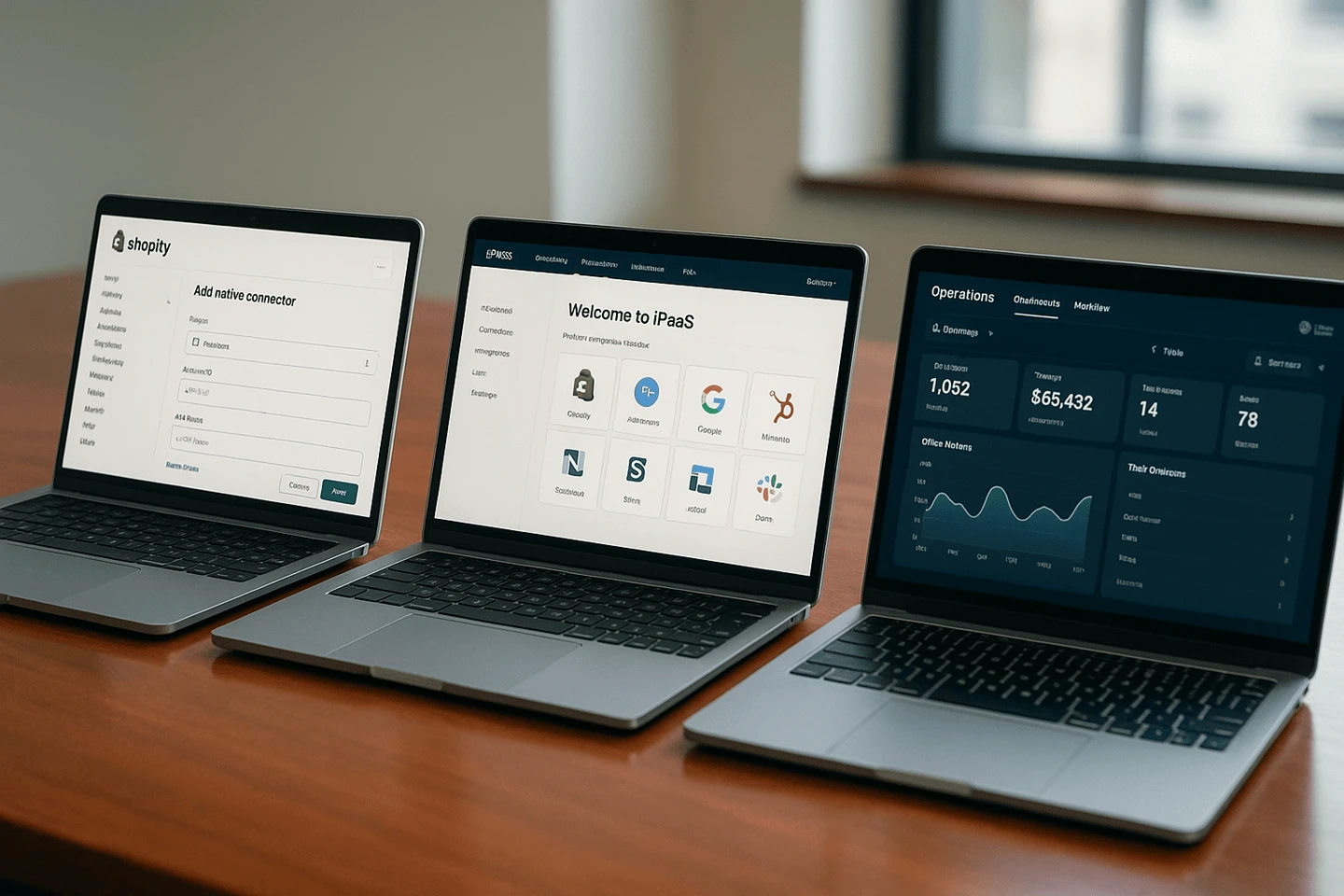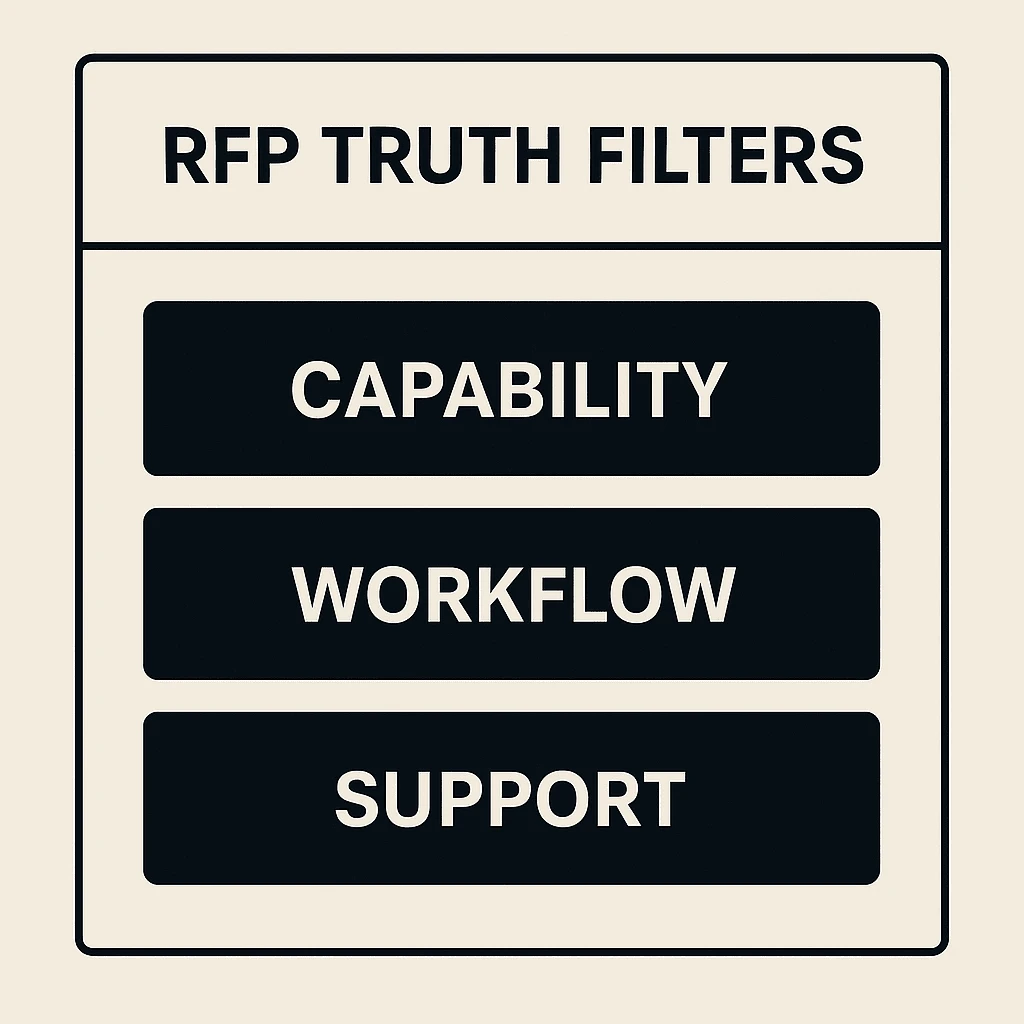NetSuite Shopify Integration Software: How to Evaluate Vendors (2026)
TL;DR: Choosing NetSuite Shopify integration software requires evaluating vendors beyond feature lists. This guide provides the RFP questions, demo evaluation framework, and reference check strategy that separates vendors who deliver from those who disappoint.
Why vendor selection is harder than it should be
Every NetSuite Shopify integration software vendor promises "seamless integration" and "real-time sync." The feature matrices look identical. The demos work perfectly. Then you go live and discover "multi-warehouse support" means two warehouses maximum.
After watching one retailer spend $80k on a platform that couldn't handle bundle orders (despite the vendor confirming capability three times during sales), you learn to ask better questions. Turns out "we support bundles" has more interpretations than a modern art exhibition.
McKinsey’s research on integrated technology models shows that when digital and IT operations work as one, companies face half as many integration challenges and are 60% more likely to turn technology investments into measurable value. That alignment is what modern operations platforms replicate across systems like Shopify and NetSuite.
Understanding what you’re comparing
NetSuite Shopify integration software falls into three categories based on vendor approach:

Native connectors: Purpose-built Shopify apps for NetSuite sync. Fast setup, rigid mapping, vendor-dependent customisation. Best under 500 orders/month with standard products.
iPaaS platforms: Integration platforms like Celigo or Boomi connecting multiple systems. Flexible workflows, requires technical knowledge, suited for complex landscapes.
Operations platforms: Infrastructure like Exsited treating integration as one capability within a broader operational system. Extends to portals and workflows, designed for growth beyond sync.
The category determines your flexibility, support model, and whether you'll outgrow it in 18 months. For a detailed comparison of approaches, see Shopify NetSuite Integration: The Complete 2026 Guide.
Operations platform approach: When integration becomes infrastructure
Operations platforms deserve deeper explanation because this architectural approach is newer and less understood than connectors or iPaaS. For businesses planning growth beyond basic sync, operations platforms represent a different category of NetSuite Shopify integration software that provides flexibility that connectors can't match. Full transparency: this is Exsited's category.
What defines operations platforms
Unified data model: Orders, items, and customers exist as platform objects that both systems connect to. Business logic lives in the platform layer, not point-to-point mappings.
Workflow orchestration: Approval flows and exception handling configured by operations teams, not buried in code.
Extensibility: Same infrastructure powering sync extends to custom portals and workflows without rewrites.
Operational visibility: Real-time dashboards with role-based access showing system state and pending actions.
When this makes sense
Consider a platform approach if your roadmap includes:
- Multi-channel expansion (B2B, wholesale, dealer portals) within 12-18 months
- Approval workflows and exception routing requirements
- Compliance demands requiring comprehensive audit trails
- Desire to configure internally versus vendor professional services dependency
One fashion retailer started with basic sync, then six months later wanted a wholesale portal with custom pricing and approvals. Their connector couldn't extend, requiring $60k separate development. An operations platform would have enabled launch in 2-3 weeks.
The distance between "we can customise that" in the sales demo and "that'll require professional services" six months later is a journey many ops teams know too well.
Exsited positions in this category: integration plus operational infrastructure. We cost more monthly than basic connectors, but 24-month TCO becomes competitive when factoring in the elimination of manual exception handling and the ability to launch capabilities without separate projects.
RFP questions that reveal truth
Skip 147-item checklists. Ask questions that force vendors to show their hand:
Capability validation
"Walk me through exactly how your platform handles a bundle order where one component is out of stock, another ships from a different warehouse, and the customer used a promotional code. Show me in your demo environment."
This single question reveals whether they've actually built bundle logic or just claim support. Watch their face carefully, if they suddenly need to "check with engineering," that's your answer.
"Show me audit logging for a failed sync. I want to see exact field-level data that caused failure and how your platform surfaced it to users."
Generic "sync failed" messages mean you're blind. Field-level logging means you can troubleshoot.
"Describe your three most complex customer implementations. What made them complex? What edge cases broke during testing?"
Complex implementations tell you whether they can handle yours.

Customisation and workflow
"We need manager approval for orders over $10k. Can I configure that myself, or does it require your professional services?"
The answer tells you whether you're buying flexibility or vendor dependency.
"Show me how I'd add a second warehouse with different routing rules. Walk through configuration steps."
If every change requires vendor involvement, calculate that ongoing cost.
"We're planning a B2B portal next year. Does your platform support that as an extension, or is that separate?"
Operations platforms extend to new capabilities. Connectors require separate systems.
Support and partnership
"What does your support SLA cover? Define response time by severity. What counts as business hours?"
"24/7 support" means nothing without specific commitments.
"Connect me with two customers similar to our size who went live 12+ months ago. I want to ask about your worst support failure."
References focused on problems reveal vendor character.
"Walk me through your product roadmap. How do you incorporate customer feedback?"
Roadmap transparency shows whether your needs get prioritised.
Demo evaluation: Beyond happy paths
Demos work perfectly with clean data. Here's what matters when evaluating NetSuite Shopify integration software in action:
Bring your own data
"Here's a real bundle SKU from our catalogue with inventory across two warehouses, a customer with negotiated pricing, and a promotional code that should apply. Process that order in your demo environment and show me what lands in NetSuite."
Vendors comfortable with their platform will agree. Those with shaky capability will deflect to "prepared examples." There's a unique joy in watching a sales engineer's confidence evaporate when you hand them actual data.
Break things deliberately
"Cancel that order after partial fulfilment. Show me how that propagates."
"Process a return for damaged versus restockable goods. Walk through inventory and credit memo impact."
Platforms that handle exceptions gracefully become operational foundations. Those that stumble… crumble in production.

Evaluate error visibility
"Show me your error dashboard. Pull up actual failed syncs. Walk through diagnosis."
Platforms with comprehensive logging show field-level data and resolution steps. Weak platforms show "sync failed" and generic codes.
One electronics retailer evaluated three vendors. Only one showed field-level error logs during demo. That visibility saved approximately 200 hours of troubleshooting in year one.
Reference check questions
Vendors provide happy customers. Extract useful information:
"How closely did implementation match the initial timeline and cost? Where were the surprises?"
Patterns reveal vendor estimating accuracy.
"What breaks regularly? How fast is the resolution? Give me your last support escalation example."
Speed and quality of resolution determine operational impact.
"What percentage of orders need manual intervention? What drives exceptions?"
High exception rates mean the platform doesn't match operational reality. If their answer is "almost none" and you're in ecommerce, someone's lying. Probably them.
"If choosing today, would you select the same vendor? Why or why not?"
This is the money question. Hesitation tells everything.
One retailer called five references. Three enthusiastic, one lukewarm, and one complained about support. That distribution mattered.

Contract negotiation essentials
Pricing protections
- Transaction volume caps with tier pricing locked upfront
- Professional services hourly rates in writing
- Annual increases capped at CPI or 5%
Performance requirements
- 99.9% uptime minimum with credits for failures
- Support response SLA by severity level
- Implementation timeline with reasonable penalties
Exit rights
- 30-60 day termination after initial term
- Complete data export in standard formats
- Transition assistance during migration
One retailer negotiated an acquisition termination clause. When the vendor was acquired 18 months later and the new owner changed direction, that clause saved them.
Selection timeline
Realistic process takes 4-5 months for straightforward implementations, 6-9 months for complex operations:
Weeks 1-2: Requirements definition and internal consensus
Weeks 3-4: RFP to 4-6 vendors, eliminate non-qualifiers
Weeks 5-6: Demos with top 2-3, bring your data, break things
Weeks 7-8: Reference checks and contract negotiation
Week 9: Selection and project team establishment
Weeks 10-18: Implementation, testing, training, parallel run
Week 19+: Production cutover and optimisation
Anyone promising "live in two weeks" delivers demos that don't handle edge cases, or you're accepting significant risk. The businesses that succeed with integration are the ones that treat Week 1 as seriously as Week 18. Data quality determines everything that follows.
Common questions
How many vendors should we evaluate?
Start with 4-6 NetSuite Shopify integration software vendors, narrow to 2-3 for detailed demos, and deep conversations with the top 2. More creates paralysis, fewer means you haven't validated the market.
Should we hire a consultant?
Consider if you lack integration expertise, need a complex enterprise RFP, or require neutral navigation of politics. Skip if you understand your requirements clearly and have internal project capability.
What if budget only supports connectors but we need more?
Honest answer: simplify processes to fit capability, delay growth until the budget supports infrastructure, or accept higher manual labour as an ongoing cost. No magic solution to capability/budget mismatch.
Start with connectors, but plan an explicit 12-month migration when the budget allows. Don't pretend it will scale if you know it won't.
How do we evaluate vendor financial stability?
Check years in business (prefer 5+), funding status, customer count and retention, and employee reviews. Ask directly: "What's your funding status and runway?"
Small vendors can be great but carry risk. Enterprise vendors provide stability but may not prioritise you. Make an informed trade-off choice.

Where to next
Vendor selection determines the operational foundation for 2-3 years. Invest time to evaluate properly, ask hard questions, validate through references, and negotiate protective contracts.
Related content:
- Integration overview: Shopify NetSuite Integration: The Complete 2026 Guide
- Implementation planning: How to Implement NetSuite Shopify Integration: Step-by-Step Planning Guide
- Enterprise requirements: Shopify Plus ERP Integration: Enterprise Implementation Playbook
- Multi-channel integration: NetSuite Multi-Channel Integration: Shopify + Amazon + POS in Sync
Ready to discuss vendor selection? Book a consultation to walk through your requirements and evaluation criteria.
References
McKinsey & Company (2020). Products and Platforms: Is Your Technology Operating Model Ready?









